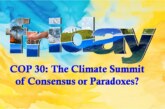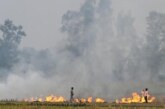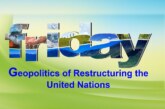
Dr. Arvind Kumar*
From deadly wildfires to devastating floods, disasters wreaked havoc across the world in 2024, set to be the world’s hottest year on record. It shook millions of lives and caused billions of dollars in damage. As the climate crisis intensifies, there is no question that the intensity and frequency of extreme weather—often resulting in disasters—is increasing.Everyday decisions in urban planning, infrastructure, poverty reduction, and environmental management are also exacerbating disaster risks. In such cases, our collective knowledge on risk reduction is not being applied to address current, new and emerging challenges. According to the IPCC’s most recent report on climate adaptation, disasters fueled by the climate crisis are already worse than scientists originally predicted. And now, the scientists have presented evidence that additional warming is locked in. That means disaster risk will grow, even if the world does succeed in limiting the greenhouse gas emissions that drive the changing climate. As per World Bank South Asia is one of the most vulnerable regions to weather- and climate-related shocks, with nearly 750 million people impacted by one or more climate-related disasters in the past two decades.
It does not have to be this way. Proactive measures to remove obstacles to sustainable development by reducing vulnerability and exposure to hazards can act as shock-absorbers, buffering the impact of increasingly intense hazard events. The sustainable development of future generations requires us to embed resilience as a core principle that underpins engineering, ecology and social development. Inclusive Disaster Risk Management is an approach that integrates the diverse needs, experiences, and capabilities of all individuals, particularly marginalized groups, into the planning, implementation, and recovery stages of disaster management. Traditional disaster risk management has often focused on providing immediate relief and has been driven primarily by top-down policies. However, these approaches can overlook vulnerable populations, including people with disabilities, women, children, elderly individuals, indigenous communities, and those with socio-economic disadvantages. Inclusive disaster risk management ensures that all segments of society are considered in disaster planning and response. The strategy involves empowering and involving marginalized groups in decision-making and adapting policies to make disaster preparedness, response, and recovery accessible and effective for everyone.
One of its fundamental principles are recognizing that disasters affect people differently based on their social, economic, and physical circumstances. For instance, individuals with limited mobility may face additional challenges during an evacuation, or children may experience heightened trauma due to disruption in their routines and education. Inclusive disaster risk management tailors’ strategies to accommodate these unique needs, ensuring that every individual receives adequate support. This holistic approach reduces the impact of disasters on vulnerable populations and fosters resilience, which is essential for reducing long-term vulnerability. Engaging vulnerable communities in the planning phase also helps create solutions that are more sustainable and culturally appropriate, as these groups bring unique insights and knowledge about their challenges and environments.
Inclusion and Resilience Building
Inclusion in disaster risk management involves integrating different types of knowledge and expertise into risk assessments and preparedness plans. Local knowledge and traditional practices often provide valuable insights into the historical resilience of communities, helping to predict possible outcomes and develop effective response strategies. Indigenous and local knowledge systems, in particular, have been integral in managing natural resources sustainably and adapting to environmental changes. By incorporating these perspectives, it builds on pre-existing community resilience and enhances it through inclusive policies. In addition to making preparedness efforts more effective, this approach encourages a sense of ownership and responsibility within communities, as they become active participants in their safety and well-being.Gender inclusivity is also crucial in IDRM. Women, especially in developing countries, often play key roles in managing resources, taking care of families, and serving as community leaders. However, they are disproportionately affected by disasters due to socio-economic inequalities, limited access to resources, and restrictive cultural norms. Women’s voices are frequently underrepresented in disaster planning and decision-making processes, leading to strategies that may not address their specific needs. Including women in disaster risk management is critical to improving community resilience, as their experiences and skills are essential for effective planning and response. Programs that empower women and enhance their leadership in disaster preparedness not only strengthen communities but also promote gender equality.
Children and elderly individuals are particularly vulnerable during disasters due to their physical, emotional, and social dependencies. IDRM prioritizes the inclusion of these age groups by providing specialized support, such as age-appropriate education on disaster preparedness for children and additional health resources for elderly individuals during recovery phases. Schools play a significant role in educating children about disaster preparedness and response, which can make a notable difference in their safety during emergencies. Similarly, involving the elderly in planning and preparedness efforts recognizes their knowledge and life experience, and also helps address any mobility or health challenges they might face during a disaster.
Age-inclusive disaster management enhances overall resilience by ensuring that all age groups are supported and prepared for potential emergencies.People with disabilities face unique challenges in disaster situations. They may encounter difficulties with physical mobility, communication, or accessing emergency services, making them more vulnerable during evacuations and relief efforts. IDRM addresses these challenges by designing evacuation routes, shelters, and communication strategies that are accessible to people with disabilities. Providing accessible information and ensuring that emergency infrastructure is designed with universal access in mind can make a significant difference in the survival and recovery outcomes for these individuals. By including people with disabilities in disaster risk planning and response activities, IDRM builds an environment that is safer and more inclusive for all, allowing people of all abilities to participate actively in their own protection and recovery.
Multistakeholder partnerships are crucial for inclusive disaster risk management, it bring together diverse actors who contribute unique perspectives, resources, and expertise toward building resilience against natural and human-made hazards. Inclusive disaster risk management involves proactive efforts to mitigate, prepare for, respond to, and recover from disasters in ways that consider the needs and capabilities of all segments of society, including vulnerable and marginalized communities. The involvement of various stakeholders, such as governments, non-governmental organizations, private sector entities, civil society organizations, academic institutions, and community groups, fosters a holistic approach ensuring that actions taken are equitable, sustainable, and responsive to local contexts.One of the primary motivations behind multi-stakeholder partnerships in DRM is the complex nature of disasters, which demand responses that are beyond the capacity of any single entity.
Disasters often cut across multiple sectors, impacting infrastructure, health, education, and economic stability. Governments are frequently the lead actors in disaster management; however, they are not always equipped with the resources or localized knowledge necessary to address every aspect of disaster response. By collaborating with NGOs, community organizations, and the private sector, governments can create a more robust and well-rounded response framework. This collaborative approach is also essential in the preparedness and mitigation phases, where multiple perspectives can help identify potential vulnerabilities, allocate resources effectively, and design systems that are adaptable to different scales and types of disasters.
Inclusive disaster risk management also emphasizes the importance of data collection and risk assessment that accurately reflect the needs of marginalized populations. International cooperation and policy alignment play a significant role in advancing inclusive disaster risk management, as seen in frameworks such as the Sendai Framework for Disaster Risk Reduction 2015–2030. This global initiative advocates for inclusive and people-centered disaster risk management practices, encouraging countries to adopt policies that consider vulnerable populations and promote equity in disaster response and recovery. Finally, inclusive disaster risk management recognizes the importance of mental health support and psychosocial care for affected individuals, especially vulnerable groups who may experience prolonged trauma due to their socio-economic and physical circumstances. By incorporating mental health support into disaster management plans, IDRM helps communities recover not only physically but also emotionally, building resilience and reducing the long-term psychological impact of disasters. Psychosocial support is critical for children, women, and elderly individuals who may experience heightened stress due to loss, displacement, or disruption in their daily routines.
Way Ahead
Inclusive disaster risk management is a transformative approach that aims to protect and empower all individuals in society, regardless of their socio-economic status, physical ability, or cultural background. By addressing the diverse needs and vulnerabilities within communities it creates a more resilient and equitable society capable of withstanding the impacts of natural and human-made disasters. This approach goes beyond immediate disaster relief and recovery, promoting long-term resilience and reducing the risk of future disasters. Multi-stakeholder partnerships are indispensable for inclusive disaster risk management, as they enable a comprehensive and coordinated approach to building resilience and reducing disaster risks. By leveraging the unique strengths of each stakeholder group, these partnerships promote equity, sustainability, and cultural sensitivity in IDRM strategies. Effective collaboration, supported by adequate funding, technological innovation, capacity building, and community engagement, can significantly enhance disaster preparedness, response, and recovery efforts, ultimately protecting lives, livelihoods, and ecosystems from the adverse impacts of disasters.
*Editor, Focus Global Reporter





